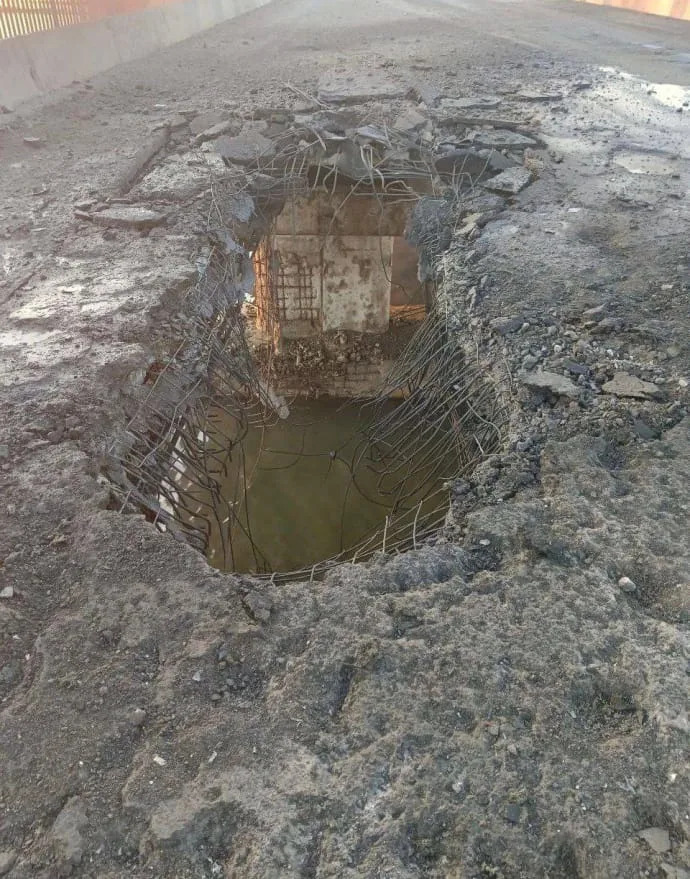Ukraine further isolates Russian controlled Crimea
...
Ukrainian forces may be intensifying efforts to strike Russian ground lines of communication (GLOCs) in southern Ukraine. Ukrainian Melitopol Mayor Ivan Fedorov reported on explosions in Melitopol and Yakymivka in Zaporizhia Oblast and Chonhar in Crimea on June 22.[26] Russian sources claimed that Ukrainian forces conducted a Storm Shadow strike on the Chonhar Bridge, along the E105 highway connecting Russian-occupied Kherson Oblast and Crimea.[27] Some Russian sources claimed that Ukrainian forces also struck a bridge across Lake Syvash.[28] Ukrainian forces may be intensifying their efforts to strike rear areas and vulnerable areas along GLOCs to disrupt Russian supply routes.[29] Widespread Russian milblogger outrage and concern about the strike could indicate that Russian forces may be increasingly concerned over their ability to secure GLOCs in southern Ukraine.[30]
Ukrainian President Volodymyr Zelensky acknowledged that Western partners have different expectations for Ukraine’s counteroffensive and stated that Ukrainian forces will perform operations as Ukraine sees fit independent of pressure from another country.[31] CNN reported on June 22 that senior US and other Western officials stated the Ukrainian counteroffensive thus far has failed to live up to expectations, but the officials acknowledged that the counteroffensive is still in the early phases and Western states remain hopeful that Ukrainian forces will make significant gains.[32] ISW continues to assesses that the slow pace of current Ukrainian counteroffensive operations is not emblematic of Ukrainian forces’ overall offensive potential and that Ukrainian forces are likely setting conditions for a future main counteroffensive effort which will take time to conduct.[33]
...
The attacks on the bridges further weaken the Russian ability to supply occupied areas and are likely to expand to other bridges and routes of Russian supply operations.
See, also:
Russian invaders start panicking after strike on bridge to Crimea, says official
...
“Today’s explosions on the Chonhar bridge, as we can see from the photo and video, remind the invaders of a similar situation with the Kherson bridge, which paved the way for the liberation of the right bank,” he said.
“This is a certain associative series that causes panic among the Russian military.”
Explosions overnight on June 22 were reported not only near the village of Chonhar in Kherson Oblast, where the bridge is located, but also near the town of Dzhankoy in occupied Crimea. However, the occupying authorities are trying to cover up the results of the strike, Chystikov added.
“Dzhankoy has been panicking since morning,” the official said.
“Local residents are reporting a large number of explosions in this area, which the occupation authority is silent about. Many Crimean residents are engaged in the transportation industry. Now their relatives have started to worry as they cannot contact the drivers by phone, and this results in the spread of negative opinions and dissatisfaction with the authority’s actions.”
...
And:
And:
...
Saldo stated that, "according to a preliminary assessment, British Storm Shadow missiles were used." In addition, Saldo posted a photo of the Chonhar Bridge.
And:
Formidable patrol boats are giving Ukraine the edge along the Dnipro River
...
With little armor, the US-donated Dauntless Sea Ark patrol boat relies on speed to evade attacks, and its impressive maneuverability is a key asset for Ukraine’s recently established river fleet.
“We’re looking for any kind of enemies everywhere, air, on land and on the river as well,” Captain Anton, his surname withheld for security reasons, says of his mission. “All the river Dnipro, from the north to the south, the riverine fleet must protect it.”
With a length of almost 1,400 miles (2,200 km) the Dnipro is the fourth longest river in Europe, rising in Russia, flowing through Belarus and Ukraine, before finally ending in the Black Sea. It cuts through Ukraine, connecting some of its major cities — such as Kyiv, Dnipro, Zaporizhzhia and Kherson — providing water, electricity and a natural barrier against advancing armies.
...
And:
Russia loses 5 Ka-52 Alligator attack helicopters in as many days
And:
Schools give patriotic lessons and teach students how to assemble rifles, while textbooks have been rewritten to favor Russia’s view of history. Factories produce uniforms for soldiers fighting Ukraine. Summer camps run by state-owned conglomerates host children from occupied Ukrainian territory.
These by-now familiar scenes would hardly bear mention in wartime Russia, except that these were drawn recently from Belarus, an autocratic country of 9.4 million neighboring Russia, Ukraine and the NATO members Poland, Lithuania and Latvia. Long uneasily in the orbit of President Vladimir Putin of Russia, Belarus is increasingly doing his bidding, socially, militarily and economically.
The most recent manifestation of Belarus’ fealty to Moscow — and the threat it poses to the West — is its professed decision to allow Moscow to position tactical nuclear weapons on its soil, as well as outfitting its bombers with nuclear weapons. It is also an important step, democracy advocates and military experts say, toward Russia’s absorption of Belarus, a longtime goal of Putin.
“Belarus’ sovereignty is evaporating very fast,” said Pavel Slunkin, a former Belarusian diplomat who is now a fellow at the European Council on Foreign Relations. “Any sphere you take, Russia’s control has become extremely big and it’s increasing.”
It wasn’t always this way. Throughout the post-Cold War era, the country’s authoritarian leader, Alexander Lukashenko, played a clever game, professing loyalty to Moscow and championing the Soviet slogans of the “brotherhood and unity,” while making sure that relations with Moscow never got too close to threaten his hold on power. He even reached out occasionally to Western nations eager to draw Belarus closer to Europe economically.
That arrangement developed cracks in 2014, after Russia seized Crimea, raising the alarming possibility for Lukashenko that Belarus, too, could be swallowed by its larger neighbor. Putin reinforced those fears by speaking openly of a political union of the two states.
...
And:
Russia is using Thermobaric missiles on insurgents inside its own borders

Comments
Post a Comment